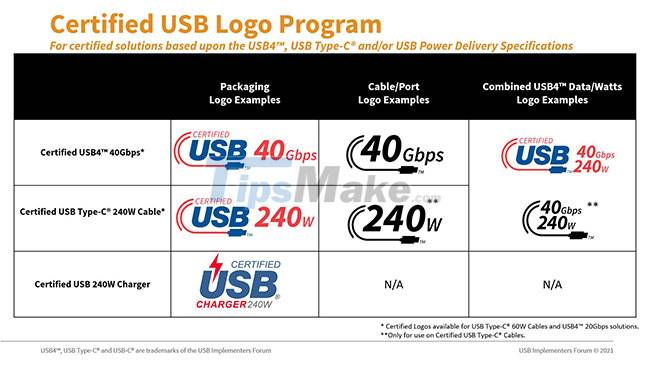USB-IF announces new list of USB-C logos, making it easier to choose a charging cable
The USB Implementers Forum (USB-IF) - the organization responsible for maintaining the USB standard on various versions - has just introduced a list of new logo templates based on the power ratings supported by a variety of USB standards. New Type-C. This is said to be helpful in making it easier for users to choose the right product for their needs.
These new logo templates will be printed directly on the packaging of licensed USB-C chargers and cables from USB-IF. Thereby helping customers easily grasp the product's type, charging capacity and data transfer support quickly and easily.

For example, with these new logos, users will be able to quickly determine if the USB-C cable they are planning to buy supports 60W or 240W charging capacity, similar to that identified in the spec sheet. technical USB Power Delivery 3.1 or not. This is necessary because the continuous launch of new models of USB-C charging cables, supporting so many different levels of parameters today can lead ordinary consumers to get lost in the 'maze', when they want to. Find a product that fits your needs.
However, this new logo list also partly shows that the USB-C standard is still relatively 'confusing' in practice, despite being simplified. For example, there are separate logos indicating the ability to support data transfer rates of 40Gbps, 20Gbps, as well as 2 levels of power specifications: 240W and 60W. More complicated is that standards may not be tied together: One cable supports 40Gbps data transfer but slower charging. While the 240W cable that supports fast charging is not suitable for high-speed file transfers. And there are many other situations.
Compared to Thunderbolt 4, things are significantly simpler. The Thunderbolt 4 standard has only a single cable, but it can cover everything in the spec sheet, not as messy as USB-C.
This problem mainly stems from the fact that USB-C standards have grown to overheat in just the past few years, resulting in still limited possibilities for optimization and simplification. There's still a long way to go before the USB-C standard can achieve the handy 'plug-and-play' status.
You should read it
- How to design a simple logo in Photoshop
- How to create a logo super fast and beautiful with professional Logo design software AAA Logo
- Firefox launched a new flat-design logo with 23 Beta version
- 5 Steps to Design a Free Logo on Canva
- Facebook launches a new logo, simple but with many implications
- Google edited the logo, the puzzle you discovered
 Google wants to help users better access reliable information sources on the internet
Google wants to help users better access reliable information sources on the internet Epic Games Store and Amazon Appstore will soon be integrated into Microsoft Store
Epic Games Store and Amazon Appstore will soon be integrated into Microsoft Store The first error on iPhone 13
The first error on iPhone 13 This application may be the culprit causing the rapid battery drain of iOS 15
This application may be the culprit causing the rapid battery drain of iOS 15 Appears new malware specializing in stealing Steam, Epic Games and EA Origin accounts
Appears new malware specializing in stealing Steam, Epic Games and EA Origin accounts Which iPhone is supported for the longest iOS upgrade? List of vintage and obsolete iPhones in 2021
Which iPhone is supported for the longest iOS upgrade? List of vintage and obsolete iPhones in 2021